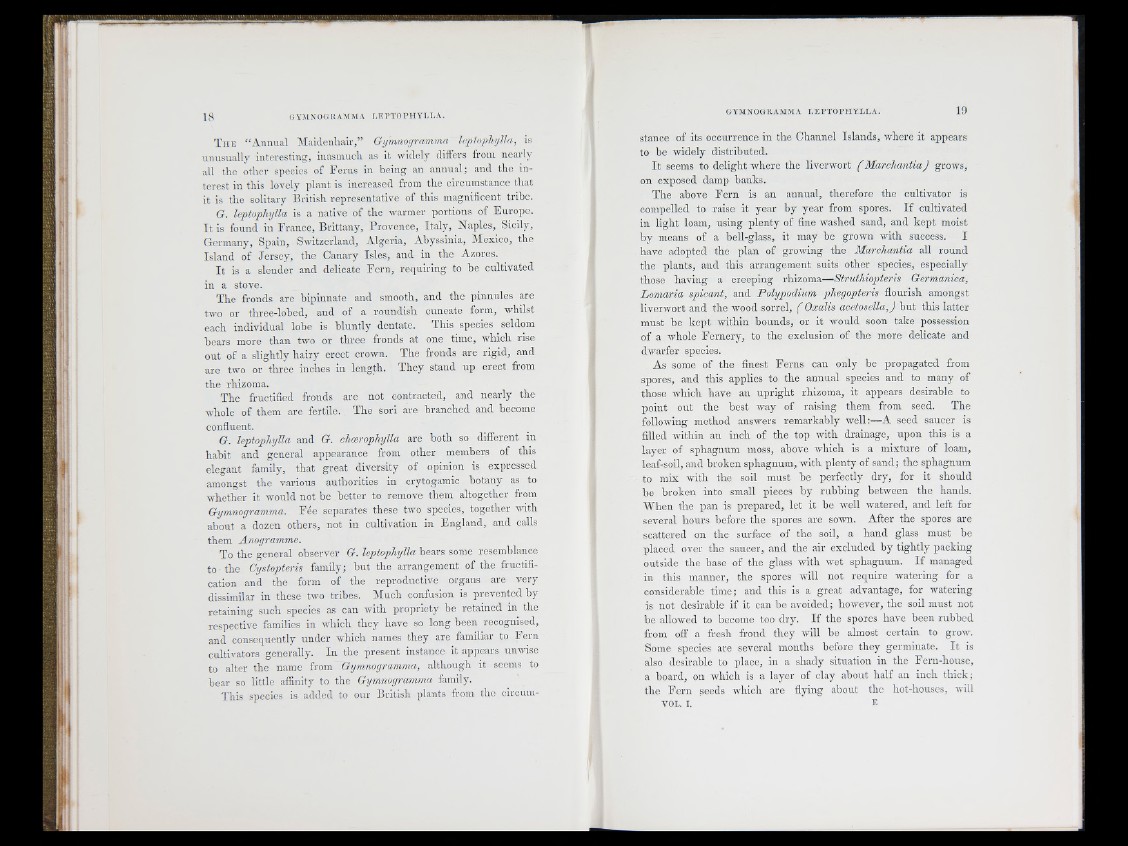
'P h e “ Annual IMaidenliair,” Gijnmogramnut leptophijlla, is
unusually interesting, iuasinucli as it widely diflers from nearly
all the other species of F erns in hoing an annual; and the in terest
in this lovely plant is increased from the circumstance that
it is the solitary ilritish representative of this magnificent tribe.
G. lepiophgUa is a native of the warmer portions of E uro p e .
I t is found in F rance, Brittany, Provence, Ita ly , Naples, Sicily,
Germany, Spain, Switzerland, Algeria, Abyssinia, ^loxico, the
Islan d of Je rsey, the Canary Isles, and in the Azores.
I t is a slender and delicate F e rn , req u irin g to ho cultivated
in a stove.
The fronds are hipinnate and smooth, and the pinnules are
two or three-lohed, and of a roundish cuneate form, whilst
each individual lobe is b lu n tly dentate. This species seldom
bears more th an two or th re e fronds at one time, which rise
out of a slightlv h a iry erect crown. The fronds are rig id , and
are two or three inches in length. T hey stand u p erect from
the rhizoma.
The fructified fronds are not contracted, and nearly the
whole of them are fertile. The sori are branched and become
confluent.
O. leptophylla and G. chosrophylla are b oth so different in
hab it and general appearance from other members of this
elegant family, th a t great diversity of opinion is expressed
amongst the various authorities in crytogamic botany as to
w'hether it would not be b e tte r to remove them altogether from
Gymnoyrainma. F e e separates these two species, together with
about a dozen others, not in cultivation in E n g lan d , and calls
them Anogramme.
To the general observer G. leptophylla bears some resemblance
to the Cystopteris family; b u t the arrangement of the fructification
and the form of the reproductive organs are very
dissimilar in these two tribes. Much confusion is prevented by
retaining such species as can with pro p rie ty he retained in the
respective families in which they have so long been recognised,
and consequently u n d e r which names they arc familiar to F e rn
cultivators generally. In the p resent instance it appears unwise
to alter the name from Gymnogramma, although it seems to
hoar so little affinity to the Gymnogramma family.
'i'his species is added to our British plants from the circumO
YM N O G ItAM H A I .E I ’T O I 'I IY L L A . 19
stance of its occurrence in the Channel Islands, where it appears
to he widely distributed.
I t seems to delight whore the liverwort ( Marchantía J grows,
on exposed damp banks.
T he above F e rn is an annual, therefore the cultivator is
compelled to raise it year b y year from spores. I f cultivated
in lig h t loam, using plenty of fine washed sand, and k ep t moist
by means of a bell-glass, it may be grown with success. I
have adopted the plan of growing the Marchantía all round
the plants, and this arrangement suits other species, especially
those having a creeping rhizoma—Struthiopteris Germánica,
Lomaría spicant, and Polypodium pliegopteris flourish amongst
liverwort and the wood sorrel, ( Oxalis acetosella,) b u t this latter
must he k e p t within bounds, or it would soon take possession
of a whole F e rn e ry , to the exclusion of the more delicate and
dwarfer species.
As some of the finest F e rn s can only be propagated from
spores, and this applies to the annual species and to many of
those which have an u p rig h t rhizoma, it appears desirable to
p oint out the best way of raising them from seed. The
following method answers remarkably well:—A seed saucer is
filled within an inch of the top with drainage, upon this is a
layer of sphagnum moss, above which is a mixture of loam,
Icaf-soil, and broken sphagnum, with p lenty of sand; the sphagnum
to mix Avith the soil must he perfectly dry, for it should
be broken into small pieces by rubbing betiveen the hands.
W h en the pan is prepared, le t it be ivell watered, and left for
several hours before the spores are sown. After the spores are
scattered on the surface of the soil, a h an d glass must he
placed over the saucer, and the air excluded by tig h tly packing
outside the base of the glass ivith wet sphagnum. I f managed
in this manner, the spores will not requ ire watering for a
considerable time; and this is a gre a t advantage, for rvatering
is not desirable if it can be avoided; however, the soil must not
be alloAVcd to become too dry. I f the spores have been ru bbed
from off a fresh frond they will be almost certain to grow.
Some species are several months before th ey germinate. I t is
also desirable to place, in a shady situation in the Fern-house,
a board, on which is a layer of clay about h a lf an inch th ick ;
the F e rn seeds ivhich are flying about the hot-houses, ivill
VOL. I. E